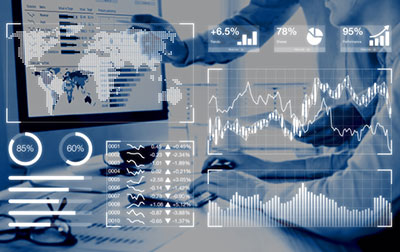Unraveling digital transformation: Pulling the data thread

Digital transformation is more than a buzzword; it’s an ongoing journey that Hatch is navigating by gathering and utilizing data to gain insights, support decision-making, and foster a digital-first approach across three key components: people, processes, and technology.
In doing this, we focus on the ways strategic integration of digital technologies across all aspects of an organization is revolutionizing operations, client interactions, and business models. And most importantly, by starting with the end in mind, we uncover how the digital landscape is fostering efficiency, innovation, and adaptability.
The power of data: Connecting the threads
From simple documents to intricate 3D models, data takes myriad forms with more teams relying on a digital-first approach. Whether executing a fast-paced project or operating a facility, organizations need to ensure they’re harnessing data the right way. Hatch, along with our clients, is going through a digital transformation, and this journey is predominantly about gathering and collecting data to gain insight and support decision making.
The key to success in these endeavors lies in connecting the data to identify trends, optimize processes, and provide teams with invaluable insight. The strength of this approach becomes evident when all team members are connected and contributing to a shared truth; that is, with regards to data, all team members are contributing to the same pool of information. If one team member steps out of the environment and doesn’t connect to the data or use it, the power of the data diminishes and falls into the realm of dark data, where it isn’t visible or relevant. People, processes, and technologies are intricately linked and must work harmoniously in order to be effective.
Data: the new gold
Data is not just a number on a spreadsheet. While it encompasses simple forms, it’s also used in complex plans and procedures and can be used to identify trends, optimize processes, and provide teams with better insight to improve decision-making. The power of this approach comes when all team members are connected. If all teams contribute, there will be new opportunities and new processes for teams to adapt that will create new opportunities and projects. Every interaction with each other and our computers is generating this data, and if all this information reports to the same location, we can fully leverage its power.
But why is this important?
To put it simply, remaining focused on data is a smart business decision, and it’s never too late for organizations to start. It takes time remove dark data and harness what’s left, and organizations are at varying levels in their digital maturity. But as organizations shift from paper to digital realms, they’re all seeing the same thing: growth in the potential for collaboration.
Interestingly, it’s only by reflecting that we can see this growth. At Hatch, we’ve come from the staged approached of marking up hard copies of drawings in-office and waiting on colleagues to finish markups before the next steps can be set in motion to a collaborative digital environment—think of it is a metaverse where clients, partners, and global colleagues can meet to interact and manipulate data, moving the design and operations processes along by replacing the potential for bottlenecks with a data-centric approach. With the aim to become fully predictive, the digital transformation helps us advance documentation and our approach to 3D models. “Mark-up rooms” have become data realms where we can all dial in to the environment together.
This transformation also enables construction teams to connect in new ways with other disciplines. It allows them to visualize events, and enhance operations across procurement, fabrication, and construction. By becoming more predictive, data ultimately helps teams to forecast and assist their decision-making.
What’s next?
Understanding clients’ needs is crucial for feeding existing operations with the required data. By maintaining its value, especially for decisions in later stages of operations within the metaverse—or the idea of working within a 3D model and all necessary stakeholders—becomes a powerful visual.
Part of our core business is the delivery of physical assets. To ensure we have the data we need to support our clients in their digitalization journeys, and that they’re able to maintain the operations and assets that we’re implementing into their ecosystems, we need to understand our clients’ needs and begin with the end in mind. We need to understand their existing systems and operations, and what our clients need to manage their assets and facilities.
To illustrate these points and the ways that connected data supports teams, consider maintenance teams when they’re out in the field—how can the team determine if an asset is under performing? How is that task executed or triggered? Do they have the latest information to make the right decisions?
This example extends to safety and maintenance teams to execute standard operating procedures before they’re out in the field. The connected upstream data is valuable even later in operations and for asset maintenance. This connected data evolves and can be used again for a future project.
To take this a step further, imagine maintenance teams leveraging augmented reality and walking through the field with that information and connectivity at their fingertips. Digital transformation is not an on/off switch. It’s a gradual process—a journey that takes time. By starting with the end in mind and focusing on early adopters who drive technology adoption forward, Hatch ensures that we handle data in a way that gives our clients the right information when they need it to support their digital transformation journeys. This delivery supports the connected worker and is required to sustain operations into the future.
By doing this, we can grow together and ensure a sustainable future through digital transformations. We can actively shape the future through the power of connected data. Contact us to find out more on about our digital journey or follow more discussion through our podcast series on digital transformation.
